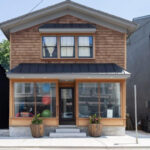For over a century, Denmark Street in London has resonated as the spiritual heart of music. While today it’s famed as the go-to destination for musicians of all levels to acquire instruments, its history is deeply intertwined with the formative years of music icons like The Beatles, the Rolling Stones, David Bowie, and the Sex Pistols. However, the street’s musical heritage stretches back even further, predating the rock and roll era. In the pre-war period, Denmark Street thrived as the hub of music publishers, their storefronts brimming with sheet music for popular tunes such as South of the Border and Lambeth Walk. Despite significant urban development in recent times, Denmark Street resolutely holds its ground as London’s unparalleled street of sound.
But what makes Denmark Street so intrinsically linked to music? A confluence of historical, geographical, and architectural elements offers insights into why certain urban locales flourish and adapt amidst constant change. Let’s delve into the origins: Denmark Street, a relatively short 60-meter stretch, is situated just off Charing Cross Road, near the bustling intersection of Oxford Street and Tottenham Court Road. It was established in the 18th century as a residential street within the parish of St Giles, a district known for its less-than-reputable past, once home to a leper hospital and struggling to shed its stigmatized image. Charing Cross Road’s burgeoning reputation for bookshops provided a logical setting when music publisher Lawrence Wright relocated his business from Leicester to London in 1911. Music publishing was initially an extension of the book trade because, prior to the widespread availability of affordable recorded music, sheet music was the primary means for individuals to enjoy popular songs at home by playing them personally. Sheet music was a lucrative commodity, and a successful publisher could amass considerable wealth from a hit song – a feat Wright achieved repeatedly.
Denmark Street’s strategic location as a connecting route between the theatre districts of Soho and Covent Garden was also advantageous. Musicians seeking to learn current popular songs naturally gravitated to Denmark Street to obtain the necessary sheet music. As more music publishers established themselves in the area following Wright’s lead, the street began attracting songwriters who would present their latest compositions to publishers, often utilizing office pianos for impromptu performances. Subsequently, “pluggers” emerged, tasked with persuading prominent artists to perform newly acquired songs. These diverse individuals – publishers, songwriters, and pluggers – frequently interacted in the street’s cafes and pubs, exchanging ideas and cultivating professional networks.
This dynamic remained consistent for decades. The advent of rock and roll and affordable vinyl records brought about significant change. However, Denmark Street demonstrated its adaptability as recording studios began to appear, catering to a new wave of self-taught musicians. The street’s architecture facilitated this transition; spacious Georgian buildings were easily repurposed into multi-occupancy spaces. Anyone involved in the music industry could find a foothold on Denmark Street, and the street’s legacy is reflected in the careers of numerous celebrated artists. The Rolling Stones recorded at number 4; The Beatles signed a pivotal publishing contract at the corner of Denmark Street and Charing Cross Road; David Bowie formed band lineups at La Gioconda café at No 9; and Elton John gained early industry experience as an office boy at one of the remaining publishing houses, before record labels assumed the role of talent scouts.
By the close of the 1960s, the original music publishers had largely departed. Denmark Street was once again on the cusp of transformation. The continued presence of music seemed improbable, yet musicians, managers, and agents maintained their daily visits to the street. To cater to this evolving clientele, instrument shops started to dominate, and the existing architecture provided a wealth of underutilized spaces ideal for musical endeavors. The Sex Pistols famously rehearsed in a workshop behind No 6, and a former blacksmith’s forge was transformed into the 12 Bar Club, a renowned small music venue in London. Both of these locations, alongside other properties on the street, are now officially listed by English Heritage, partly due to their significant musical associations.
And what about Denmark Street today? Despite the disruptive impact of the Crossrail project, Denmark Street endures. Noel Gay, the last of the original publishers, is gone, but instrument shops continue to operate beneath offices now converted into hotel rooms for Chateau Denmark, a rock-themed establishment. The 12 Bar Club has been reborn as The Lower Third – named after one of David Bowie’s early bands formed during his Denmark Street period – and plans are underway for a new recording studio further down the street. It’s undeniably different from its past iterations, but Denmark Street has never been static. Its enduring appeal lies in its capacity to evolve, remaining as resilient, adaptable, and vital as music itself, solidifying its status as London’s iconic street of sound.

